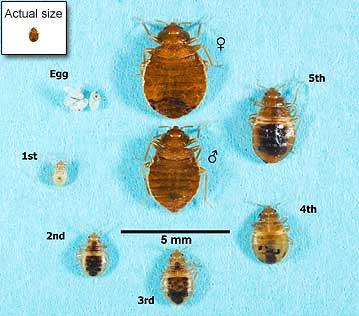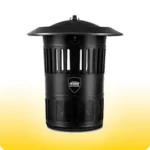Bed Bugs: The Good, The Bad And The Ugly

So how do you know if it is a bed bug?
What is a bed bug’s life cycle?
What are the symptoms of bed bug bites?
What are the signs of infestation?
How did these bugs get here anyway?
What to do about an infestation?
Bed bugs are a small oval-shaped brown insect that can quickly infest your home if they have the opportunity. These insects are transported by people on their body, clothing and in luggage from infested hotels and hostels and immediately take up residence in a mattress, on the headboard of your bed or behind pictures on the wall.
Bed bugs do not carry diseases, nor do they transmit them, but they do bite and their bite can be very irritating and itchy, depending upon your sensitivity to insect bites. Bed bugs move quickly across surfaces and hide during the day, so you really need to look carefully for them when you check into a hotel, for example. Check the seams of the mattress and the headboard for small brown oval bugs.
Bed bugs are nocturnal so this means that they hide during the day and come out at night to feed. They have a relatively painless bite so you may not know that you have been bitten unless and until you carefully inspect your body for bites. Some people have a serious and noticeable reaction to bed bug bites with red weals on their skin while others have no reaction at all. It can be disconcerting to wake up in the morning covered in bites and not realise where they came from.
So how do you know if it is a bed bug?
Bed bugs have certain characteristics including their shape and size. A bed bug does not have wings and cannot fly. Each bug is around 10 mm long, so they are very small and difficult to see. They are flat and are light brown in colour. Their colour becomes rusty-red after they have had a blood meal. Bed bugs have large mandibles (that they bite with) and large antennae. They can remain dormant for several months if there are no live blood meals available. They have flat heads and oval bodies which gives them a very distinctive look. They are very sensitive to extreme temperatures, so using steam on mattress seams can result in the eradication of these pests.
Still not sure if you have bed bugs? Take a look at this handy reference: http://dailyentertainment.me/health/how-to-tell-if-you-have-bed-bugs
What is a bed bug’s life cycle?
Bed bugs mate through the process of traumatic insemination. A female bed bug is inseminated through her abdomen by the male with his hypodermic genitalia (which sounds painful!). The female bed bug will lay between 3 and 5 eggs around the edges or the buttons of a mattress or the eggs may be glued to rough surfaces. Fertilised females that have a ready food supply can lay eggs continually during their life span which is around nine months and it can be as many as 300 eggs! The eggs are milky white in colour and look similar to grains. Eggs are 1mm long, around the same size as two grains of salt and hatch in 6 – 17 days. The eggs yield immature bed bugs that are looking for a blood meal. The freshly-hatched nymphs are yellow-white in colour and will become reproductive adults within five weeks.
A bed bug takes about 21 days to develop into an adult and the adult bed bugs feed weekly and can live between four and six months, although some adults can survive a full year if the temperature is cold enough. A single female can cause a large infestation in a few short months if the problem is not detected and dealt with quickly enough.

(Picture source: http://www2.epa.gov/bedbugs/bed-bugs-appearance-and-life-cycle)
How do bed bugs eat?
Bed bugs live by feeding on blood and nothing else. They live in mattresses and in bedrooms because when we are asleep we are at our most vulnerable, unable to ward off any attack. The bugs are attracted by the carbon dioxide that we breathe out. Bed bugs will bite the human body, usually on the arms and shoulders. When a bed bug is feeding it will pierce the skin of the victim with a proboscis and then inject their saliva which contains an anti-coagulant. They may sit on the surface of the skin and feed for several minutes until they become swollen and rounded. At this point they will drop off of the skin and drag themselves away to an area where they can lay their eggs, hidden from view.
Here is a video that depicts a bed bug biting a man’s arm:
What are the symptoms of bed bug bites?

Picture source: http://www.bed-bugs-handbook.com/pics-of-bedbug-bites.html
Bed bug bites are usually red and have a darker spot in the middle. The may be arranged either in a cluster or in rough line. They are generally found on the face, hands, arms and neck and it is important to refrain from scratching them or they may become infected. Cover the bites with an antiseptic cream or lotion and try to numb your skin with an ice pack so that you will not be tempted to scratch it. Antihistamines can also be helpful in reducing the itching and symptoms of bites.
What are the signs of infestation?
If you suddenly experience bed bug bites, then you should search for the possible infestation. Bed bugs are able to hide quite easily because they have a unique body shape. Check in the bedrooms (or in a hotel room) in these areas: along the seams and buttons of mattresses, in wallpaper (seams), on the bedding, in the carpet, on the headboard, floor and walls around the bed. If a bed bug infestation is new, you may only have a small colony in your home. If you think you have bed bugs, keep checking and making a careful inspection of the area, looking for the tell-tale signs of bed bugs which include: small dark or rust-coloured spots (bed bug excrement), small blood stains on bedding, bed bugs in the various areas that are described above, and an offensive odour that is very noticeably sweet and musty.
You won’t find bed bugs in your hair because they do not have the same body modifications as lice and fleas which have special claws that allow them to navigate around hairs. Bed bugs prefer smooth skin that is close to the area where they are hiding so that they can get their blood meal and then get back to their hiding place quickly.
How did these bugs get here anyway?
People are always mystified as to how they ended up with an infestation in the first place. The most common cause, believe it or not, is you! If you travel often and stay in hotels, every time you put your luggage down you run the risk of these little critters hitching a ride. They can hide in your clothes and then when you arrive at your home, they take up residence and start to populate by quickly reproducing. Bed bugs are commonly found in accommodations that have a high turnover rate of occupants including motels, hotels and hostels. You may also bring these bugs home when you decide to purchase second hand furniture at a garage sale or from another residence that may have a bed bug infestation. Always take a close look at second hand mattresses, bed frames or other furniture that has seams where bugs can hide. Also consider close inspection of art prints with frames and bedding.
What to do about an infestation?
Prevention is better than trying to deal with an infestation, but if you discover that you have bed bugs, you must deal with them immediately. Upon your return home from a vacation, make sure that you wash and dry all of your clothes and bags (if possible) at the highest setting available on your dryer for a minimum of 15 minutes. If you are very diligent with your housekeeping – vacuuming, dusting and washing walls, etc. this can be a deterrent to infestation too.
Consider using a bed bug mattress cover.

These specially designed covers protect your mattress if you do not yet have an infestation and prevent existing bed bugs from escaping the mattress. The bugs that are on the mattress will eventually die because they cannot escape from the cover which has a tightly woven framework. Protective covers should be left in place on the mattress for one year, since bed bugs can live that long without a blood meal.
Products such as disinfectants that you spray to kill bacteria and odours are not an effective tool against bed bugs. You will need to be careful what kind of products you use around your bedroom as far as poisons that kill insects because you will be breathing those in when you lie in your bed. If you plan to use highly toxic products, it is best to avoid sleeping in the bedroom for a few days until the toxins have cleared the air. A better choice is to use products that are effective on the bed bugs but not harmful to humans or pets. The mattress covers are a great option because they do not harm you or your mattress and are extremely affordable.
Finally, you should know that there is no such thing as a stupid question. There are always topics like this one that many people will avoid because they find it distasteful. The truth is that bed bugs are enjoying a population explosion around the world, thanks to how easy it is to travel around the world in modern society. If you flew to Europe and then home to Australia, you might be packing a lot more than souvenirs with you in your luggage! Always be extremely cautious and check your luggage when you return to your home because bed bugs are tenacious little creatures and you do not want your own infestation problem!
Check out our bed bug control products > займ онлайн безработнымзайм ижевсккак получить займ через систему контакт





 Mosquito Traps
Mosquito Traps